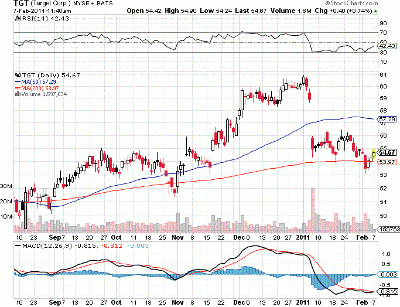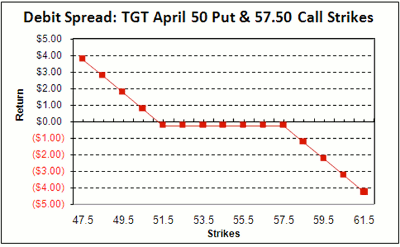Target Corp. (TGT) announced last week that its January same-store sales rose by 1.7%, just missing the consensus estimate for sales growth of 1.9%. The company noted that sales were below its own expectations, especially in the south and northeast. However, Target said that it expects "meaningful increases" in its fiscal 2011 same-store sales.
Perhaps keying off the company's positive outlook, traders bid TGT shares nearly 1% higher that day. Technically, the equity is attempting to hold support just above the $53 level, which is home to its rising 60-week moving average and 200-day moving average just above that.
Overhead resistance, however, has stymied the security since the beginning of the year, with the $55 level providing short-term resistance.
Looking to take advantage of the situation, options traders piled into both TGT puts and calls late last week, nearly tripling the stock's daily average on both fronts. The most active put contract was the April 50 strike, where some 3,500 contracts crossed the tape, while the April 57.50 strike took top spot on the call side, with more than 5,600 contracts changing hands.
Taking a closer look at both strikes, I uncovered what appears to be either a collar (most likely) or an extremely bearish debit spread on TGT. First, a block of 2,702 April 50 puts traded at the ask price of $0.85, or $85 per contract. The block was marked "spread," with the other half of the trade crossing on the call side of the coin. Second, the trader sold 2,702 April 57.50 calls for the bid price of $0.60, or $60 per contract. The result is a debit of $0.25, or $25 per pair of contracts.
For the uninitiated, a collar is an options trade established by simultaneously buying a protective put and writing a covered call on a stock already in the trader's portfolio. However, while the premium received from the sold call will help to offset the cost of the put (or even exceed it), the written call will also cap the investor's upside in the wake of an extended rally.
Assuming that the strategy is indeed a collar on an existing long TGT position, the trader has set the stop loss at $50 per share and profit target at $57.50 per share. Furthermore, he/she has given TGT until April expiration to hit either level. Depending on when the long TGT stock position was entered, the trader can limit losses to practically nothing, or to a specific percentage, or even lock in profits.
On the other hand, if the trader does not own TGT shares, the options strategy becomes an extremely bearish debit spread, with unlimited upside risk due to the sold out-of-the-money call. With the April put bought for $0.85 and the April call sold for $0.60, the trader would need TGT to fall below $49.75—a 7.6% decline from the stock's current perch near $53.87—in order to reach breakeven on the position.
By Joseph Hargett, contributor, Schaeffer’s Trading Floor Blog

























